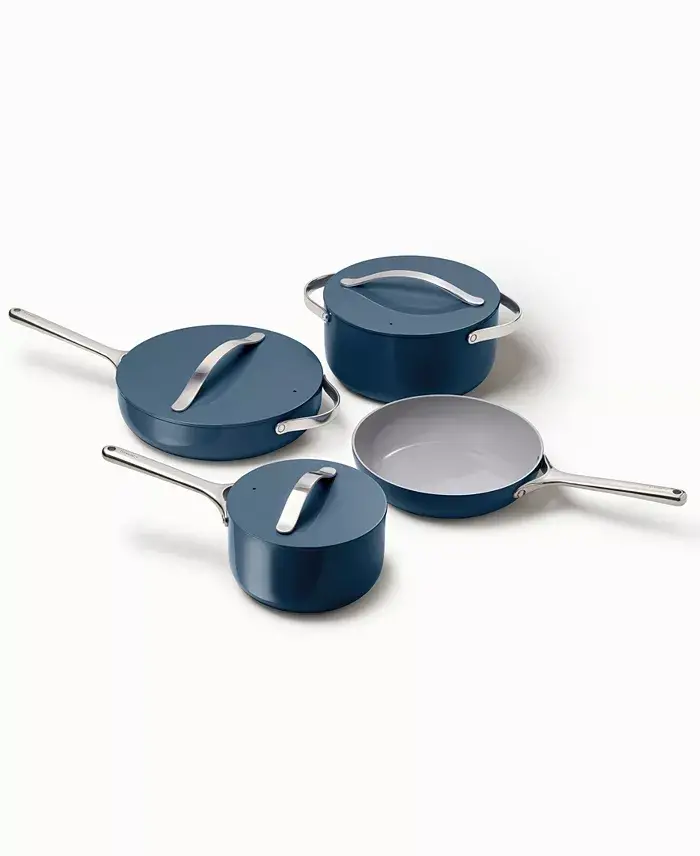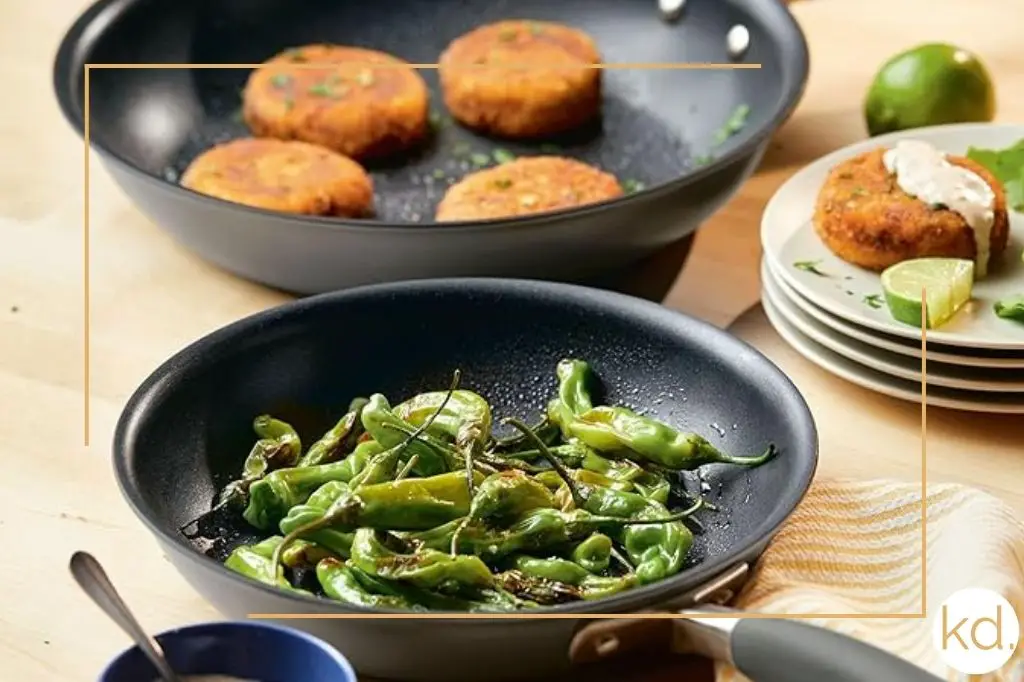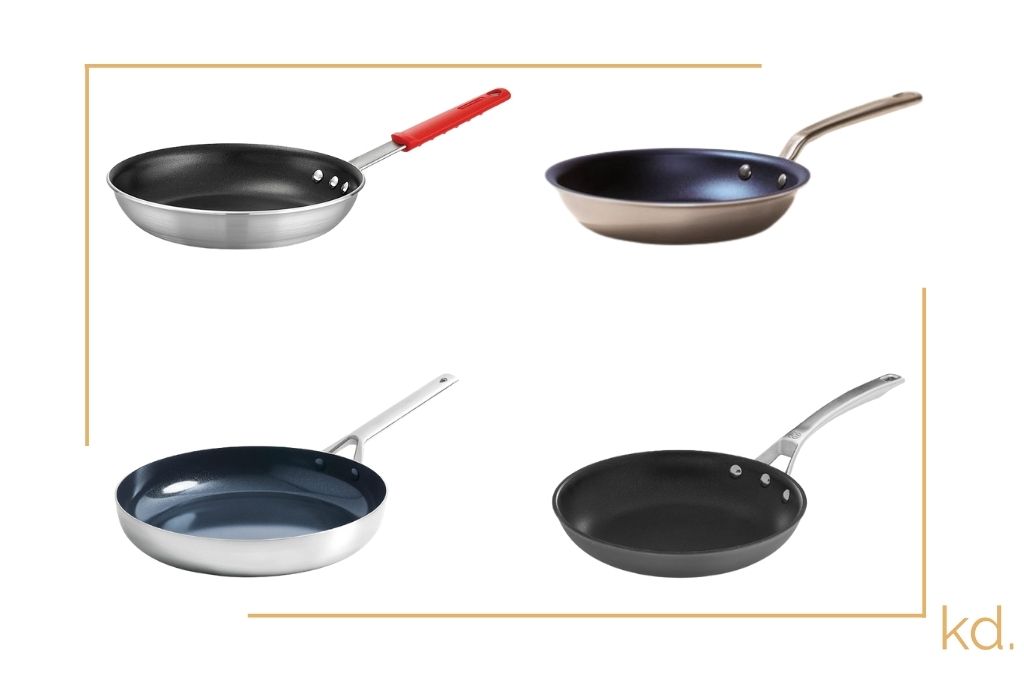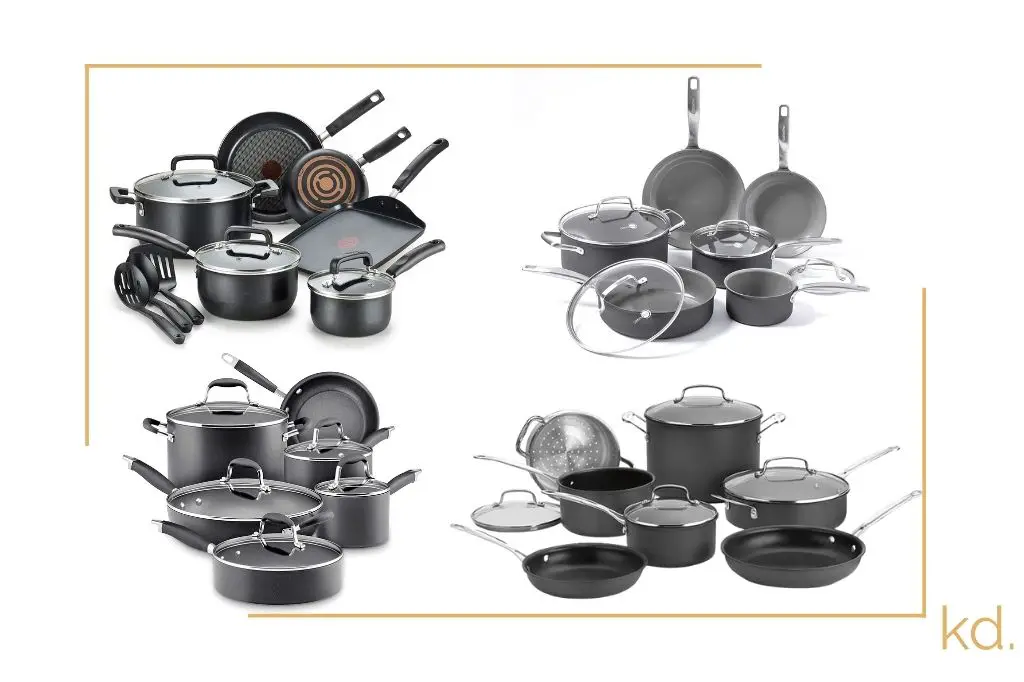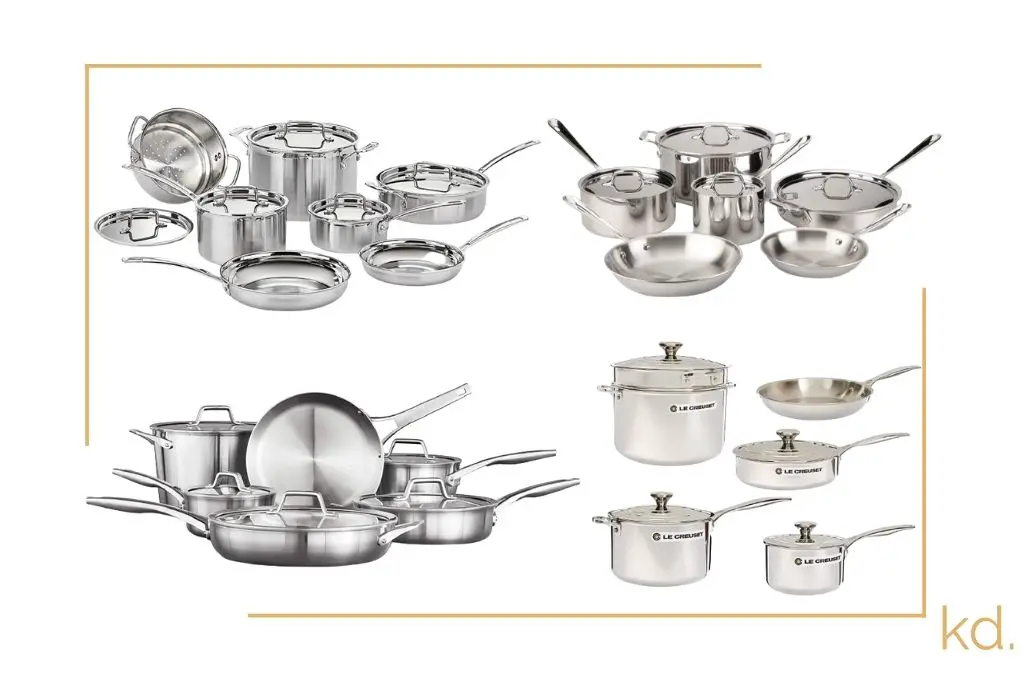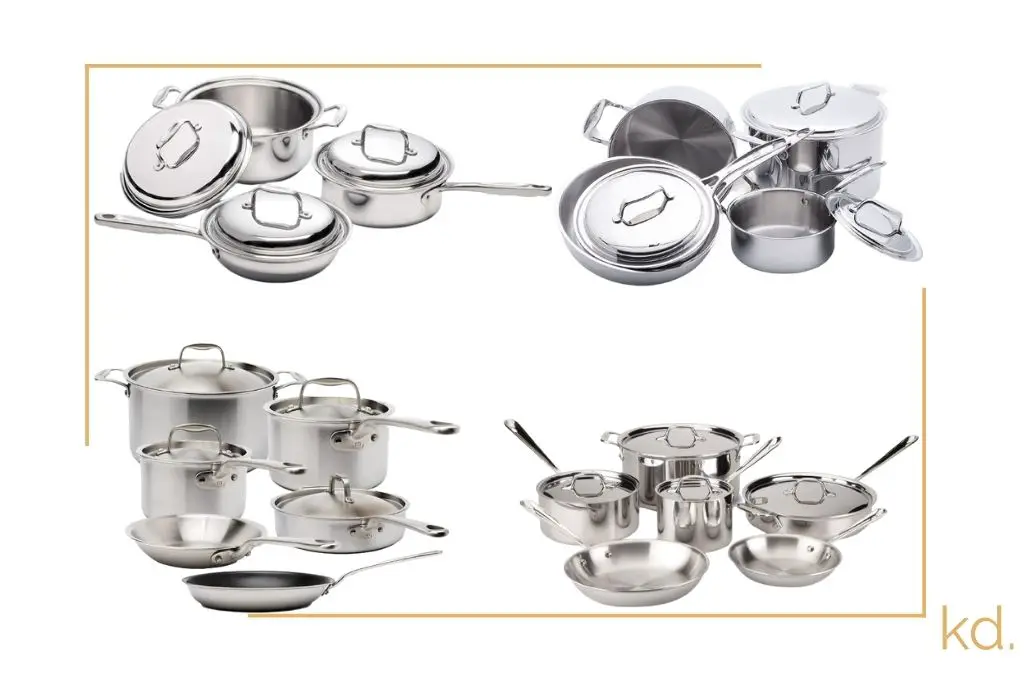Looking to ditch those potentially harmful pots and pans? You’re not alone! With increasing awareness about chemicals leaching into food, more home cooks are making the switch to non toxic cookware. I’ve researched extensively to bring you this comprehensive guide to the best non-toxic options available today.
Let’s explore cookware that combines performance with peace of mind, so you can focus on what matters – creating delicious meals without worrying about what might be sneaking into your food.
Quick Comparison Chart
| Cookware | Material | Heat Capacity | Maintenance | Best For |
|---|---|---|---|---|
| Caraway Cookware Set | Ceramic non-stick | Medium-High | Easy | All-purpose cooking |
| Lodge Cast Iron Skillet | Cast iron | Very High | Moderate | High-heat cooking, searing |
| Le Creuset Dutch Oven | Enameled cast iron | Very High | Easy | Slow cooking, stews |
| GreenPan Valencia Pro | Ceramic non-stick | Medium-High | Easy | Everyday cooking, eggs |
| All-Clad Stainless Steel | Stainless steel | High | Moderate | Professional cooking |
| Xtrema Pure Ceramic | 100% ceramic | Medium | Moderate | Chemical-free cooking |
| Pyrex Glass Bakeware | Tempered glass | Medium | Easy | Baking, food storage |
| Cuisinart MultiClad Pro | Stainless steel | High | Moderate | All-purpose cooking |
| Staub Cocotte | Enameled cast iron | Very High | Easy | Braising, bread baking |
| Made In Blue Carbon Steel | Carbon steel | Very High | Moderate | High-heat cooking, wok skills |
Why Choose Non-Toxic Cookware?
Traditional non-stick cookware often contains PFAS (per- and polyfluoroalkyl substances) like PFOA and PTFE (commonly known as Teflon). When heated above 500°F, these can release harmful fumes and potentially leach into food. Aluminum cookware might also leach metal into acidic foods, while some low-quality metals contain lead, cadmium, or other concerning substances.
Switching to non-toxic cookware offers several benefits:
- Health safety: Minimizes exposure to potentially harmful chemicals
- Environmental friendliness: Many non-toxic options have a lower environmental impact
- Durability: Quality non-toxic materials often last longer than conventional non-stick
- Better taste: Many chefs report cleaner, purer flavors when cooking with non-toxic materials
Now let’s dive into the best non-toxic cookware options available today!
Top 10 Non-Toxic Cookware Options
1. Caraway Cookware Set
Material: Ceramic-coated aluminum with non-toxic, non-stick ceramic coating
Caraway has exploded in popularity for good reason – their cookware combines sleek aesthetics with practical non-toxic performance. The ceramic non-stick coating is free from PFAS, PTFE, and other potentially harmful chemicals.
What’s included: The complete set features a 10.5″ fry pan, 3-quart sauce pan, 4.5-quart sauté pan, and 6.5-quart Dutch oven, plus thoughtful storage solutions.
Pros:
- Beautiful, modern design with multiple color options
- Excellent non-stick performance without harmful chemicals
- Even heat distribution thanks to aluminum core
- Includes innovative storage solutions
- Works on all cooktops, including induction
- Oven-safe up to 550°F
Cons:
- Premium price point
- Ceramic coating requires careful maintenance to maintain non-stick properties
- Some users report the non-stick quality diminishes after about a year of regular use
- Heavier than some alternatives
Best for: Style-conscious home cooks who want a complete set of non-toxic cookware and are willing to follow proper care instructions to maintain performance.
2. Lodge Cast Iron Skillet
Material: Pre-seasoned cast iron
Sometimes the classics endure for a reason. Lodge’s American-made cast iron skillets have been kitchen workhorses for generations. The naturally non-stick surface comes from proper seasoning (a layer of polymerized oil), not chemicals.
Pros:
- Extremely durable – can literally last generations
- Superior heat retention for perfect searing and baking
- Develops a natural non-stick surface that improves with use
- Very affordable compared to other options
- Adds beneficial iron to food (particularly helpful for those with iron deficiency)
- Can go from stovetop to oven to campfire
Cons:
- Heavy and somewhat cumbersome
- Requires specific maintenance (no dishwasher, needs proper drying and occasional re-seasoning)
- Not ideal for highly acidic foods for extended cooking times
- Takes longer to heat up initially
Best for: Cooks who appreciate traditional cooking methods, want incredible searing performance, and don’t mind a bit of extra maintenance for superior results.
3. Le Creuset Dutch Oven
Material: Enameled cast iron
Le Creuset’s enameled cast iron Dutch ovens represent the pinnacle of non-toxic luxury cookware. The colorful enamel coating provides the benefits of cast iron without the maintenance concerns.
Pros:
- Exceptional heat retention and distribution
- Non-reactive enamel interior won’t leach into foods
- Handles acidic ingredients with ease
- Stunning design that doubles as serveware
- Lifetime warranty
- Available in numerous vibrant color options
- Incredibly versatile for stovetop and oven cooking
Cons:
- Premium price (investment piece)
- Heavy weight can be challenging for some users
- Enamel can chip if dropped or mishandled
- Limited non-stick properties compared to ceramic options
Best for: Serious home cooks who appreciate heirloom-quality cookware and frequently make soups, stews, braises, and bread.
4. GreenPan Valencia Pro
Material: Ceramic non-stick coating (Thermolon Minerals) on hard-anodized aluminum
GreenPan pioneered ceramic non-stick technology. Their Valencia Pro line features their most advanced coating – Thermolon Minerals Pro – which is free from PFAS, PFOA, lead, and cadmium.
Pros:
- Excellent non-stick performance without harmful chemicals
- Magneto base works exceptionally well on induction cooktops
- Metal utensil safe (though wooden or silicone still recommended)
- Oven safe up to 600°F
- More affordable than some premium ceramic options
- Dishwasher safe (though handwashing recommended)
Cons:
- Non-stick properties may degrade over time
- Some users report uneven heating
- Requires careful temperature management (no high heat cooking)
- Handles can get hot during stovetop use
Best for: Health-conscious cooks who want reliable non-stick performance without chemical concerns and particularly those with induction cooktops.
5. All-Clad Stainless Steel Cookware
Material: Multi-ply stainless steel with aluminum or copper core
All-Clad represents the gold standard in stainless steel cookware. Their tri-ply or five-ply construction sandwiches aluminum or copper between layers of non-reactive stainless steel for optimal performance.
Pros:
- Extremely durable and can last decades with proper care
- Superior heat distribution and responsiveness
- Non-reactive surface won’t leach metals into food
- Withstands high temperatures and all cooking techniques
- Dishwasher safe
- Professional appearance
- Made in USA with strict quality standards
Cons:
- Higher price point
- Learning curve to prevent sticking (requires proper preheating and oil)
- Heavier than some alternatives
- Can develop discoloration (though this doesn’t affect performance)
Best for: Serious cooks who value performance and versatility over convenience and don’t mind developing proper techniques for non-stick results.
6. Xtrema Pure Ceramic Cookware
Material: 100% ceramic
Unlike ceramic-coated options, Xtrema makes cookware from pure ceramic material – no metal core, no coating that can wear off. This makes it perhaps the most truly non-toxic option available.
Pros:
- Completely inert material that won’t leach anything into food
- Can withstand extreme temperatures (freezer to 250°F)
- Naturally non-stick when used properly
- Unique far-infrared heating properties
- Scratch-resistant surface
- Dishwasher safe
Cons:
- Significantly more expensive than most options
- More fragile than metal cookware
- Slower to heat up than metal alternatives
- Handles can get very hot during use
- Not compatible with induction cooktops without an adapter
Best for: Ultra health-conscious consumers with chemical sensitivities who prioritize purity over convenience and are willing to adjust cooking techniques.
7. Pyrex Glass Bakeware
Material: Tempered borosilicate or soda-lime glass
While not suitable for all cooking applications, Pyrex glass bakeware deserves a place in any non-toxic kitchen. It’s completely inert and perfect for baking and food storage.
Pros:
- 100% non-toxic and non-reactive
- Transparent for easy food monitoring
- Affordable and widely available
- Great for baking and food storage
- Dishwasher, freezer, microwave, and oven safe
- Won’t absorb odors or stains
Cons:
- Only suitable for oven use, not stovetop (except for specific stovetop-rated glass)
- Can break or shatter if dropped or exposed to extreme temperature changes
- Not suitable for high-heat applications
- Limited to specific cooking applications
Best for: Bakers and anyone who frequently stores leftovers or meal preps, particularly for acidic or highly flavored foods.
8. Cuisinart MultiClad Pro Stainless Steel
Material: Tri-ply stainless steel with aluminum core
Offering performance similar to All-Clad but at a more accessible price point, Cuisinart’s MultiClad Pro line delivers excellent heat distribution in a non-toxic package.
Pros:
- Excellent heat distribution and retention
- Non-reactive cooking surface
- Significantly more affordable than premium stainless brands
- Dishwasher safe
- Oven safe up to 550°F
- Compatible with all cooktops including induction
- Durable construction that will last decades
Cons:
- Learning curve to prevent sticking
- Polished surface can show scratches (though these don’t affect performance)
- Handles can get hot during extended cooking
- Heavier than non-stick alternatives
Best for: Practical home cooks looking for high-performance, non-toxic cookware without the premium price tag of luxury brands.
9. Staub Cocotte
Material: Enameled cast iron
Similar to Le Creuset but with a distinctive aesthetic and some unique features, Staub’s enameled cast iron cocottes offer exceptional non-toxic cooking performance.
Pros:
- Outstanding heat retention and distribution
- Black matte enamel interior develops non-stick properties over time
- Self-basting lid with textured interior for continuous moisture circulation
- Extremely durable construction
- Works on all cooktops including induction
- Available in beautiful color options
- Oven safe up to 900°F with metal knob
Cons:
- Premium price point
- Very heavy (7-8 pounds for a 4-quart size)
- Dark interior makes it harder to monitor fond development
- Some users find the tight-fitting lid challenging to remove
Best for: Serious cooks who make lots of braises, stews, and bread, and appreciate the unique self-basting lid design.
10. Made In Blue Carbon Steel Frying Pan
Material: Carbon steel
Carbon steel combines many of the benefits of cast iron (heat retention, durability, naturally non-stick when seasoned) with the lighter weight and responsiveness of stainless steel.
Pros:
- Excellent heat retention with faster heating than cast iron
- Develops natural non-stick properties with seasoning
- Significantly lighter than cast iron
- Can handle extremely high heat for perfect searing
- Durable enough to last generations
- More affordable than many premium cookware options
- Works on all cooktops including induction
Cons:
- Requires seasoning and maintenance similar to cast iron
- Not dishwasher safe
- Can react with acidic foods
- Prone to discoloration and patina (which is normal but may concern some users)
Best for: Culinary enthusiasts who want the performance benefits of cast iron without the weight, particularly for high-heat cooking techniques like stir-frying and searing.
Complete Buying Guide for Non Toxic Cookware
Understanding Non-Toxic Materials
When shopping for non-toxic cookware, it’s important to understand what makes materials truly non-toxic:
Safe Materials
- Ceramic: Either 100% ceramic or ceramic-coated, this material is generally free from toxic chemicals and won’t leach into food. Look for testing certifications.
- Cast Iron: Traditional and time-tested, properly seasoned cast iron creates a natural non-stick surface without chemicals.
- Enameled Cast Iron: Combines the benefits of cast iron with a non-reactive, non-porous glass-based surface that won’t require seasoning.
- Stainless Steel: Particularly high-quality 18/10 or 18/8 stainless steel is non-reactive and highly durable, though not inherently non-stick.
- Carbon Steel: Like cast iron but lighter, carbon steel develops natural non-stick properties when properly seasoned.
- Glass: Completely inert and will not leach chemicals into food, though limited to specific applications.
Materials to Avoid
- PTFE (Teflon): Can release toxic fumes when overheated above 500°F
- PFOA, PFOS, GenX, and other PFAS: “Forever chemicals” with potential health concerns
- Untested ceramic coatings: Some bargain brands may contain lead or cadmium
- Uncoated aluminum: Can leach into foods, particularly acidic ones
- Copper without proper lining: Should be lined with stainless steel to prevent copper leaching into food
Key Factors to Consider
1. Cooking Style
Your personal cooking habits should heavily influence your choice:
- Frequent high-heat cooking: Cast iron, carbon steel, or high-quality stainless steel
- Acidic foods (tomatoes, citrus, wine): Enameled cast iron, stainless steel, or glass
- Low-fat cooking: Properly maintained ceramic non-stick or well-seasoned cast iron/carbon steel
- Baking: Glass, ceramic, or enameled cast iron
2. Maintenance Preferences
Be honest about how much maintenance you’re willing to perform:
- Low maintenance: Ceramic non-stick, enameled cast iron, stainless steel
- Moderate maintenance: Seasoned cast iron, carbon steel (require proper drying and occasional re-seasoning)
- Special care required: 100% ceramic (more fragile than metal options)
3. Heat Source Compatibility
Check that your chosen cookware works with your cooking equipment:
- Induction: Requires ferromagnetic materials like cast iron, enameled cast iron, carbon steel, or specific stainless steel (test with a magnet)
- Glass cooktops: Smooth-bottomed cookware preferred to prevent scratching
- Gas/electric: Compatible with all cookware types
- Oven use: Check temperature ratings if you frequently finish dishes in the oven
4. Weight and Handling
Consider your physical comfort when handling cookware:
- Heaviest: Cast iron, enameled cast iron
- Medium weight: Stainless steel, ceramic-coated aluminum
- Lighter options: Carbon steel, aluminum with ceramic coating, pure ceramic
5. Budget Considerations
Non-toxic cookware is available at various price points:
- Budget-friendly: Lodge cast iron, basic stainless steel, Pyrex
- Mid-range: GreenPan ceramic, Cuisinart MultiClad Pro, Made In carbon steel
- Premium: Le Creuset, Staub, All-Clad, Caraway sets, Xtrema
6. Versatility
Some pieces offer more versatility than others:
- Most versatile: 12-inch skillet (cast iron, stainless, or carbon steel)
- Multi-purpose: Dutch oven (can sear, braise, bake bread, make soups)
- Specialized: Certain shapes work best for specific cooking methods
Proper Care for Non-Toxic Cookware
To maximize the lifespan of your non-toxic cookware:
Ceramic Non-Stick (Caraway, GreenPan)
- Use low to medium heat (high heat damages the coating)
- Hand wash with gentle detergent
- Avoid metal utensils
- Store with protective layers between stacked items
- Never use aerosol cooking sprays (they create residue)
Cast Iron (Lodge)
- Wash with hot water and stiff brush (mild soap is okay contrary to old myths)
- Dry thoroughly on stovetop after washing
- Apply light coating of oil after cleaning
- Store in dry place
- Re-season occasionally as needed
Enameled Cast Iron (Le Creuset, Staub)
- Allow to cool before washing
- Soak with warm water to remove stuck-on food
- Use nylon scrubbers for tough residue (no steel wool)
- Can go in dishwasher but hand washing preferred
- Store carefully to avoid chipping enamel
Stainless Steel (All-Clad, Cuisinart)
- Preheat properly before adding oil/food to prevent sticking
- Deglaze pan with liquid to easily remove stuck foods
- Can use more abrasive cleaners for stubborn stains
- Barkeeper’s Friend removes discoloration
- Dishwasher safe but hand washing extends shine
Carbon Steel (Made In)
- Season like cast iron
- Wash with hot water, mild soap is okay
- Dry immediately after washing
- Apply thin layer of oil before storing
- Will develop patina over time (sign of proper seasoning)
Frequently Asked Questions
What cookware material is least toxic?
The least toxic cookware materials are 100% ceramic, properly made glass, and high-quality stainless steel, as these won’t leach anything into your food even with acidic ingredients or high heat.
How can I tell if my current cookware is toxic?
Check for:
- Visible scratches or chips in non-stick coatings
- Manufacturing date (older Teflon contains PFOA)
- Country of origin (some countries have looser regulations)
- Strange smells when heating
- Unusual metallic taste in food
Is stainless steel completely non-toxic?
High-quality stainless steel (18/10 or 18/8) is generally considered non-toxic. Lower quality stainless steel may leach small amounts of nickel and chromium, particularly with acidic foods. Those with nickel sensitivities should be cautious.
How long does ceramic non-stick coating last?
With proper care, ceramic non-stick surfaces typically maintain their performance for 2-3 years with regular use. The coating may continue working beyond this time but with gradually reduced non-stick properties.
Can I restore the non-stick properties of ceramic cookware?
Unlike traditional non-stick, ceramic cannot be “re-coated” at home. To extend performance:
- Use proper heat levels (never high heat)
- Always use some fat when cooking
- Clean thoroughly after each use
- Season occasionally with oil
Is cast iron really non-toxic if it leaches iron into food?
The small amounts of iron that leach into food from cast iron cookware are generally considered beneficial rather than harmful, as iron is an essential nutrient. However, those with hemochromatosis (iron overload disorder) should consult their doctor.
What’s the most affordable way to switch to non-toxic cookware?
Start with a Lodge cast iron skillet ($20-30) and gradually add pieces as your budget allows. Focus first on replacing cookware you use for longer cooking times and acidic foods.
Can I use metal utensils with ceramic non-stick cookware?
While some manufacturers claim their ceramic coatings are metal utensil safe, wooden, silicone, or nylon utensils will significantly extend the life of any non-stick surface.
Is handwashing really necessary for non-toxic cookware?
For most non-toxic cookware, handwashing is recommended even if technically dishwasher safe. The harsh detergents and high heat of dishwashers can degrade non-stick properties and dull finishes faster.
What’s the single most versatile piece of non-toxic cookware to start with?
A 10-12 inch cast iron skillet offers exceptional versatility at an affordable price point. It can sear, bake, broil, fry, and even work as a serving dish.
Conclusion for Best Non Toxic Cookware
Making the switch to non-toxic cookware doesn’t have to happen overnight. Consider starting with replacing the pieces you use most frequently, then gradually build your collection as budget allows.
Among the options we’ve explored, my top recommendations for most home cooks would be:
- Best overall set: Caraway Cookware Set
- Best budget option: Lodge Cast Iron Skillet
- Best splurge: Le Creuset Dutch Oven
- Best for everyday non-stick cooking: GreenPan Valencia Pro
- Best for versatility: All-Clad or Cuisinart Stainless Steel
Remember that the healthiest cookware is the one you’ll actually use to prepare wholesome, home-cooked meals. With the right tools and proper care, your non-toxic cookware will serve you well for years – even generations – to come.
Happy cooking!
